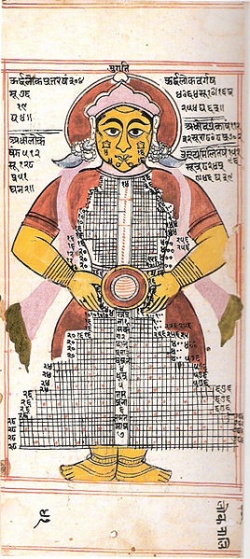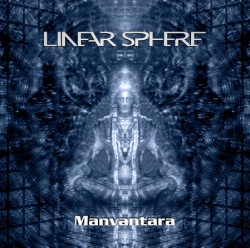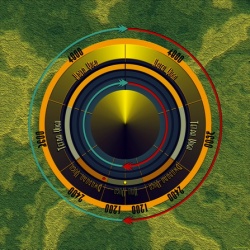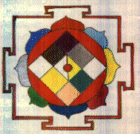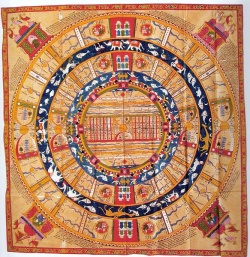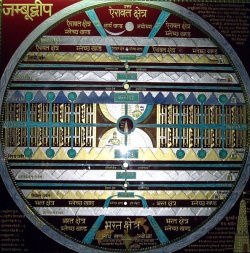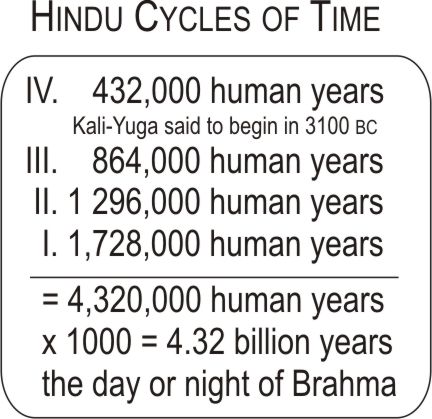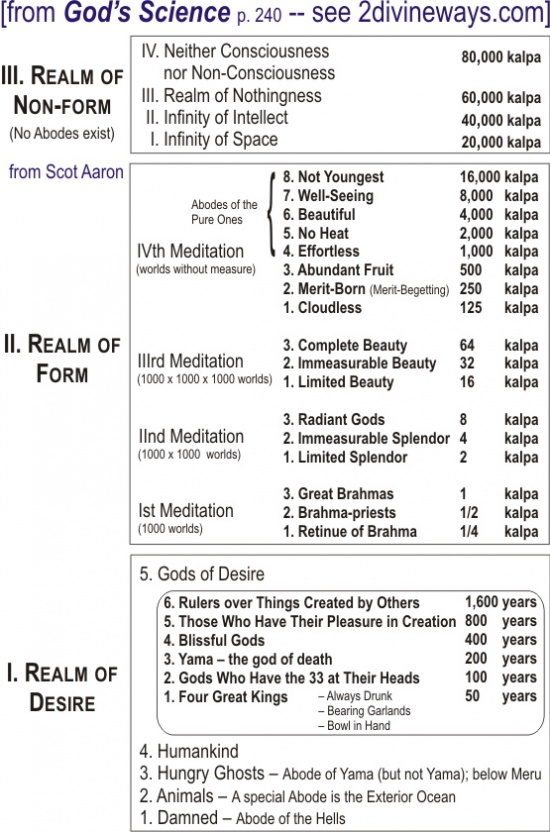Difference between revisions of "Hindu and Buddhist Cosmology"
(Created page with "thumb|250px|thumb|250px|thumb|250px|thumb|250px|File:Adhaidvipa.j...") |
|||
| Line 39: | Line 39: | ||
[[Theravada Buddhists]] have their [[Mount Meru]] [[cosmology]] (cakravala-cosmology, fig. A3.2 ). This is a single-world-system conceived as concentric rings around [[Mount Meru]], the center of the “[[world]] disk,” which means that it is the center of the [[universe]]. As will be seen, [[Mahayanist]] believers have their [[Pure Land]] and [[Celestial]] [[Buddhas]]. | [[Theravada Buddhists]] have their [[Mount Meru]] [[cosmology]] (cakravala-cosmology, fig. A3.2 ). This is a single-world-system conceived as concentric rings around [[Mount Meru]], the center of the “[[world]] disk,” which means that it is the center of the [[universe]]. As will be seen, [[Mahayanist]] believers have their [[Pure Land]] and [[Celestial]] [[Buddhas]]. | ||
| − | [[File:Buddhist- | + | [[File:Buddhist-CosmologyTABLE.jpg|frameless|550px|centre|]] |
''Figure A3.2 presents a composite of the primary [[realms]] of [[existence]], as understood from the {{Wiki|perspective}} of [[Theravada Buddhism]]. This [[adaptation]] (from Kloetzli 1983) stems from the basic [[Buddhist]] [[Wheel of Life]]. The [[God]] [[Realm]] would include consciousness/individuals from the [[Realm of Form]]. The [[Realm]] of [[Non-form]] could be considered as Buddha-Consciousness. The [[Buddhist]] “[[kalpa]]” periods of [[time]] are {{Wiki|distinct}} from the [[Hindu]] [[kalpas]].''<ref>(Adding some text from the [[Buddhist]] "[[Wheel of Life]]") Note: Scot Aaron discovered this insightful [[book]] at the {{Wiki|Academic}} library in {{Wiki|Munich}}. | ''Figure A3.2 presents a composite of the primary [[realms]] of [[existence]], as understood from the {{Wiki|perspective}} of [[Theravada Buddhism]]. This [[adaptation]] (from Kloetzli 1983) stems from the basic [[Buddhist]] [[Wheel of Life]]. The [[God]] [[Realm]] would include consciousness/individuals from the [[Realm of Form]]. The [[Realm]] of [[Non-form]] could be considered as Buddha-Consciousness. The [[Buddhist]] “[[kalpa]]” periods of [[time]] are {{Wiki|distinct}} from the [[Hindu]] [[kalpas]].''<ref>(Adding some text from the [[Buddhist]] "[[Wheel of Life]]") Note: Scot Aaron discovered this insightful [[book]] at the {{Wiki|Academic}} library in {{Wiki|Munich}}. | ||
Revision as of 19:00, 11 November 2013
This section is from the 3rd Appendix in God's Science, pp. 236-242. Scot Aaron has an academic degree in World Religions, and has traveled (backpacked) extensively in India, Tibet, Nepal, Thailand, Cambodia and China to learn more about ancient and current spiritual practices like Hinduism and Buddhism. May this brief presentation put Eastern religions in a global context of our Earth reality and inspire our personal path.
Cycles of Time in Hinduism and Buddhism
Cycles of time are prominent in the major eastern religions of Hinduism and Buddhism. These religions stem from the ancient Vedic scriptures. From the accepted stories/legends of the traditional Buddha (Siddhartha Gotama), he was a prince in northern India who rejected his privileged lifestyle to realize “enlightenment” (Nirvana). He renounced his palace life and all possessions, then lived amongst Hindu ascetics. Abandoning the techniques of his associates, he ventured out on his own and realized enlightenment. This Appendix will briefly state eastern spiritual/religious ideas concerning time and space and interpret their significance within the context of the Milky Way Model.
Eastern religions recognize the importance of energies in association to divine energies. The life-force (soul) of an individual is said to reincarnate based on the cause and affect of actions (karma). The energies of a human life can be born as an animal or even in a divine heavenly state. For Hindus, cows are sacred; Hindus typically do not eat meat. Beyond recognizing various states of consciousness, only the realization (Moksa, “liberation”) of existence exists. Essentially, the Hindus and Buddhists consider life on Earth as empty of any real substance. Life is Maya, an “illusion” of pain and suffering. In a divine sense, life is lila, the “play” of consciousness.
For a Hindu the “true self” (the Atman) is all of existence. For a Buddhist, existence in itself is empty. Only Buddha consciousness exists, translated as “clear light” by some Buddhists. Energy or consciousness has no separate self, and is realized as all of existence and nonexistence. Life eternally turns like a wheel. Energies caught in the spokes (or jaws) of mortality, are shuffled from place to place, from realm to realm (from tooth to tooth in within the jaws of death), until realizing or not realizing the axis/center of the Self, also considered as the non-self.
The four main Hindu Vedas consist of three main sections, recorded through about 1000 years up to a few hundred years B.C. Of course the faithful like to place timeless ages on their scripture. The years quoted are all rough estimations based on the accepted academic research. Following the formal, orthodox, and ritualistic Vedas (distinctly for the Brahmin priests), came numerous interpretative scriptures (the Puranas) with stories of the gods that appealed to the general population.
The Buddha wrote nothing. After the Buddha’s death, viewpoints diverged until after becoming the State religion of India with King Asoka (about 200 BC). One primary viewpoint emerged, the Theravada “teachings of the elders, of the order,” with their canon of scripture. About 300-400 years later, a foundational interpretation of the Buddha and Buddhism developed, based on the experience of Buddha consciousness, rather than teachings. (Nagarjuna, somewhere around 150-250 AD was/is a foundational philosopher for the Mahayana tradition/s of Buddhism.) Throughout Asia, various so-called “enlightened” beings were said, and are said, to trace their spiritual linage from the Buddha. Interpretations and various schools of Buddhism spread through Asia. For the Chinese, elements of Confucian ethics and Taoism mixed in with Buddhism. Although Buddhists might say that they pay less attention to cosmology than the Hindus, their cosmologies are well developed.
Clear cosmological viewpoints of time and space exist in Hindu scriptures. (See the Kurma, “Tortoise” and Visnu Puranas.) Time is calculated eons into the future and past. Although many elements of time and space go beyond sensible comprehension, the ideas resonate with the Milky Way Model. The Bible compared one day of God to 1000 human years. In Hinduism the most recognizable, relative structure of time (divine time), is the kalpa, a day and night of the creator God, Brahma. The progressive degeneration of time leads to its temporary extinction, until a “golden” age begins again.
Figure A3.1 presents the accepted Hindu concept of time. Brahma is the creator god. Although more time is combined and/or divided into other cycles, the day and night of Brahma is a kalpa, “a unit of time.” This kalpa multiplies the progressingly degenerated yugas, “ages” by 1000 for the divine day or night. We are currently considered to be in the Kali-Yuga. Dividing the kalpa by the 400,000 Relativity Ratio equals 10,800 years for the day and 10,800 years for the night of Brahma.
The 10,800 years is the similar to the predominant Greek philospher named Heraclitus (about 500 B.C.) who discussed the "Great Year." Heraclitus said (according to Kahn 1979, Crowe 1996, and the internet): “Seasons which bring all to birth, thirty years for a generation,” [and 10,800 for a great year, which is 30 x 360]. A standard interpretation of this fragment concerns the concept of a great year (magnus annus), which is mentioned within the brackets where the typical 360 day year is multiplied by 30 years per generation.
The Milky Way Model recognizes Divine Key Spirits and associated Spirit Energies within major world religions. The individual said to be the traditional Buddha (Gotama) is significant, however the energy/spirit of the Buddha provides the foundation. Major religious traditions circulate consciousness from foundational Divine Key Spirits. Regardless of a story about an individual like Gotama (apparently recorded hundreds of years later with Asoka's state religion), the fact is that for thousands of years millions of Hindus and Buddhists have focused on God to circulate God’s divine light. The spiritual energies/light from eastern religions are clearly recognized and appreciated. God’s light circulates. All individuals truly sharing/circulating God’s light are appreciated. The opening of the East has been fundamental to the progress of humankind. Many western philosophical developments can be spiritually connected to eastern viewpoints.
The Milky Way Model understands that a core spiritual power was established on the earth. About 5000-6000 years ago this power distinctly spread around the Mediterranean and to the East. Numerous remains exist in ancient Egypt, especially their Pyramid Texts. A major spiritual development also spread into India. Beyond these archeological facts, people in separate religions often insist on their superiority. History records numerous wars based on harnessing the power of believers. People of one religion go against people of other religions. In the West, Jews say Jesus was a teacher. Christians say Jesus was/is the Christ (the Jewish Messiah). The Muslims accept Jesus in the tradition of Jewish prophets, yet they place Muhammad as the supreme prophet, said to have amended Christian and Jewish misunderstandings of God.
Beyond any foundational conflict between Hinduism and Buddhism, the eternal cyclical nature of time is prevalent in both religions. Hindus perceive “ages” of time. Their million year dates do not appear to relate to any known civilizations. [Footnote 1: Hindus have compared their scripturally-based concepts of time with modern science (Bhattacharjee, 1978). This 4.32 billion years appears to agree with the approximate age of our solar system. Believers in Vishnu can also compare the various incarnations (Avatara, “descent”) of Vishnu with Darwin’s theory of evolution. Vishnu’s incarnations evolve from a fish, amphibian (a tortoise), mammal (boar), semi-human, deformed human, to full human beings like Krshna, Rama, and a future incarnation (Kalki).]
Evidence does exist for the human development of farming and agriculture about 10,000 years ago. The 1000 multiple can relate to a millennial-like energy. (A millennium is a period of 1000 years.) This 1000 is multiplied by the 4 primary “ages” in Hinduism (fig. A3.1). This total of 4.32 billion years is said to be equivalent to a day or night of Brahma, the creator God. When divided by the primary 400,000 Relativity Ratio, 10,800 years remain. This was the time quoted from Heraclitus for the "Great Year" (30 years per generation times 360 days for the year = 10,800). When divided by the Relativity Ratio, a divine day and divine night equal about 10,000 relative years each. This equates approximately 10,000 or 1000 + 10,000 relative years before the Fall/Expansion of time and space to our 10,000 + 1000 relative years right now. (The 1000 years considers the millennial period, necessary to refine Earth's peak energies.)
The Hindu conception of cosmic time scales considers 360 days for Brahma’s years and then a 100 year lifetime (8.64 billion years for the day and night of Brahma x 360 days for a year x 100 years). Cosmic speculation can continue the divine cycles within time. The Buddhists fully developed their cosmic speculations of time with the Buddha as the center of existence.
For Buddhists the supreme divine power, i.e. God, is the Buddha. The traditional Buddha (Gotama) is considered “God” for our Buddha-field. Buddhism stems from the Hindu Vedas, yet Buddhists chose not to believe in the traditional Hindu God or gods. Their perception of Brahma or any other conception of God is considered inferior to the Buddha. Proud Buddhists might amicably admit that they do not believe in God. Based on their scriptures, they mean that they do not believe in anybody else’s God, but rather a divine, all-encompassing consciousness/intelligence. With their compassion, intelligence, and spiritual practices they are here to save all sentient beings. Although the Buddha was said to announce that cosmological speculation was not necessary for enlightenment, Buddhist cosmology forms the framework of their beliefs. This includes all Buddhists, Theravada and Mayahana.
Divinity is divinity. Whether a Divine Key Spirit or consciousness that requires further illumination through the curvature of time and space to actualize divinity, all connecting universes essentially contain the same matter that circulates light. For Christians, Jesus is the center of existence, for Buddhists the Buddha is, and et cetera through every religion. Any Buddhists attached to their conception of superiority neglects Buddha’s “Noble Truths,” i.e. that attachment (ego) spreads suffering.
Buddhists have spiritually explored and detailed numerous realms of consciousness. The Buddhist Wheel of Life is the cosmological basis for understanding Buddhism. Life/consciousness extends through 6 primary realms. There are the abodes of Animals, of Humans, of Hells, of Hungry Ghosts, of Jealous Gods, and of Gods. The Wheel of Life continues because of ignorance, greed, and hatred. Consciousness (individuals) may exist for various periods of time in these realms. Although the realm of Gods can extend through numerous abodes and for lengthy periods of time, Buddha consciousness/non-consciousness is conceived to be within the center of the Wheel of Life that appears trapped within the jaws of death.
Theravada Buddhists have their Mount Meru cosmology (cakravala-cosmology, fig. A3.2 ). This is a single-world-system conceived as concentric rings around Mount Meru, the center of the “world disk,” which means that it is the center of the universe. As will be seen, Mahayanist believers have their Pure Land and Celestial Buddhas.
Figure A3.2 presents a composite of the primary realms of existence, as understood from the perspective of Theravada Buddhism. This adaptation (from Kloetzli 1983) stems from the basic Buddhist Wheel of Life. The God Realm would include consciousness/individuals from the Realm of Form. The Realm of Non-form could be considered as Buddha-Consciousness. The Buddhist “kalpa” periods of time are distinct from the Hindu kalpas.[1]
Pali Canon is said to be from the Buddha’s speeches and forms the doctrinal foundation of Theravada Buddhism. The following quote comes from the first Sutra, “Discourse” (the Brahmajala Sutra) in “The Long Discourses of the Buddha” (Digha Nikaya). The recitations (38-43, also 2.1-2.6) present a view of eternity and non-eternity (Walse, 1995).
2.1. ‘There are, monks, some ascetics and Brahmins who are partly Eternalists and partly Non-Eternalists, who proclaim the partial eternity and the partial non-eternity of the self and the world in four ways. On what grounds? 2.2. ‘There comes a time, monks, sooner or later after a long period, when this world contracts. At a time of contraction, beings are mostly reborn in the Abhassara Brahma world [a plane of flashing radiance]. And there they dwell, mind-made, feeding on delight, self-luminous, moving through the air, glorious — and they stay like that for a very long time. 2.3. (Wrong view 5) ‘But the time comes, sooner or later after a long period, when this world begins to expand. In this expanding world an empty palace of Brahma appears. And then one being, from exhaustion of his life-span or of his merits, falls from the Abhassara world and arises in the empty Brahma-palace. And there he dwells, mind-made, feeding on delight, self-luminous, moving through the air, glorious — and he stays like that for a very long time. 2.4. ‘Then in this being who has been alone for so long there arises unrest, discontent and worry, and he thinks: “Oh, if only some other beings would come here!” And other beings, from exhaustion of their life-span or of their merits, fall from the Abhassara world and rise in the Brahma-palace as companions of this being. And there they dwell, mind-made, and they stay like that for a very long time. 2.5. ‘And then, monks, that being who first arose there thinks: “I am Brahma, the Great Brahma, the Conqueror, the Unconquered, the All-Seeing, the All-Powerful, the Lord, the Maker and Creator, Ruler, Appointer and Orderer, Father of All That Have Been and Shall Be. These beings were created by me. How so? Because I had this thought: ‘Oh, if only some other beings would come here!’ That was my wish, and then these beings came into this existence!” But those beings who arose subsequently think: “This, friends, is Brahma, Great Brahma, the Conqueror, the Unconquered, the All-Seeing, the All-Powerful, the Lord, the Maker and Creator, Ruler, Appointer, and Orderer, Father of All That Have Been and Shall Be. How so? We have seen that he was here first, and that we arose after him.” 2.6. ‘And this being that arose first is longer-lived, more beautiful and more powerful than they are. And it may happen that some being falls from that realm and arises in this world. Having arisen in this world, he goes forth from the household life into homelessness. Having gone forth, he by means of effort, exertion, application, earnestness and right attention attains to such a degree of mental concentration that he thereby recalls his last existence, but recalls none before that. And he thinks: “That Brahma, he made us, and he is permanent, stable, eternal, not subject to change, the same for ever and ever. But we who were created by that Brahma, we are impermanent, unstable, short-lived, fated to fall away, and we have come to this world.” This is the first case whereby some ascetics and Brahmins are partly Eternalists and partly Non-Eternalists. (Walshe 1995, pp. 75-77)
The Buddhist Mahayana cosmologies are similar. Sajasra-Cosmology “Cosmology of Thousands” multiplies what is unified and unifies what is multiplied. Combinations of Buddhas and Bodhisattvas (“Enlightenment-Beings”) all related to a single Buddha and a single “Buddha-field” (buddhaksetra) where Gods can rule over a 1000 to 1000^100. These beliefs are clearly seen within Mahayana Buddhist scripture like the Avatamasaka-sutra, the “Flower Garland” sutra, which is also known as the Buddhavatamsaka-sutra, the”Sutra of the Garland of Buddhas.” This text is considered to be a very important and extensive compilation for Mahayana Buddhists. The Buddha is seen as the center, a focal point that unifies all spiritual energies of the universe.
"On whirlwinds rests the Fragrant Ocean, which carries an infinite number of world-germs (lokabija); from it there issue lotuses infinite in number—very far removed, indeed, from each other. From each of these lotuses is born a universe (great chiliocosm), above which (separated by whirlwinds) there are three, then five, and so no up to the twentieth tier, where there are 39 great chilocosms [[[universes]]] . . . ., on the same level at the same stage, in the extreme west, is the blessed universe of the Buddha Amitabha [the Buddha of Infinite Life/Light], the Sukhavati [the Pure Land], where a kalpa [Footnote 2] of our universe is equal to a day and night." (Kloetzli 1983, p. 52; from La Vallee Poussin, “Cosmogony,” pp. 137-138)
[Footnote 2: The Buddhist “kalpa” appears more vague than the Hindu concept. Buddhist scriptures say that a kalpa (usually meaning a Mahakalpa a “Great Aeon”) will last as long as it takes to wear down the solid rock of a mountain by a man rubbing his silk garment across it once every 100 years. Other references consider a kalpa as the time that it takes to empty a city full of poppy seeds, removing one seed every 3 years. ]
Cycles of time and space in both Hinduism and Buddhism continue through eternity. Connecting universes can be understood with Relativity Ratios. The last line quoted above, states that “a kalpa of our universe is equal to a day and night.” Put into perspective, a kalpa in the universe of the Buddha of “Infinite Life/Light” (the Buddha Amitabha) would be a day and night in the universe from which this Buddha stemmed.
Rather than diverge into fanciful speculations as a basis for cosmology (even if inspired during some point in time and space), the Milky Way Model (Celestail Cosmology) clearly recognizes God (the Male/Female/Spirit) as the foundation for our universe. Spiritual light generates our physical light. This circulates by realizing and actualizing divine potential. Hell realms can persist within nonluminous matter. Whatever energy is stored within this matter does not circulate. Light is light because energy circulates. Energies are shared. True love is an experience of light. Inspiration that motivates and inspires will circulate light. “Lost worlds” might initial appear to circulate energies, but end up gravitating towards darkness, only to orbit within this darkness.
The organization/reorganization of circulating light is an eternal, divine process. Seeds of divine potential spread throughout the curvature of time and space. Light fills every realm of heaven. Each individual that accepts God (this includes opportunities experienced in the afterlife) will circulate God’s light. Those actualizing divine potential branch through connecting universes.
Footnotes
- ↑ (Adding some text from the Buddhist "Wheel of Life") Note: Scot Aaron discovered this insightful book at the Academic library in Munich.
I. Realm of Desire:
- 5. Gods of Desire [-6. Rulers over Things Created by Others -5. Those Who Have Their Pleasure in Creation -4. Blissful Gods -3. Yama – the god of death -2. Gods Who Have the 33 at Their Heads -1. Four Great Kings (Always Drunk, Bearing Garlands, Bowl in Hand)]
- 4. Humankind
- 3. Hungry Ghosts – Abode of Yama (but not Yama); below Meru
- 2. Animals – A special Abode is the Exterior Ocean
- 1. Damned – Abode of the Hells
